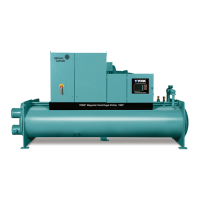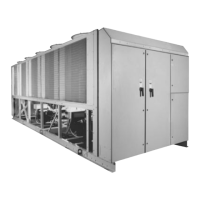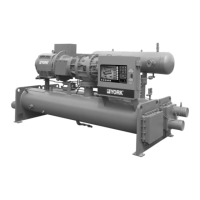JOHNSON CONTROLS
24
FORM 160.76-O1
ISSUE DATE: 05/22/2019
SECTION 6 - MAINTENANCE
3. Test around each joint and factory weld. It is im-
portant that this test be thoroughly and carefully
done, spending as much time as necessary and us-
ing a good leak detector.
4. To check for refrigerant leaks in the evaporator
and condenser, open the vents in the evaporator
and condenser heads and test for the presence of
refrigerant. If no refrigerant is present, the tubes
and tube sheets may be considered tight. If refrig-
erant is detected at the vents, the heads must be
removed, the leak located (by means of soap test
or leak detector) and repaired.
VACUUM TESTING
After the pressure test has been completed, the vacuum
test should be conducted as follows:
1. Connect a high capacity vacuum pump, with in-
dicator, to the system charging valve as shown in
Figure 11 on page 23 and start the pump. (See
Vacuum Dehydration on page 25.)
2. Open wide all system valves. Be sure that all
valves to the atmosphere are closed.
3. Operate the vacuum pump in accordance with
VACUUM DEHYDRATION until a wet bulb
temperature of +32°F (0°C) or a pressure of 5 mm
Hg is reached. See Table 2 on page 24 for cor-
responding values of pressure.
4. To improve evacuation circulate hot water (not
to exceed 125°F, 51.7ºC) through the evaporator
and condenser tubes to thoroughly dehydrate the
shells. If a source of hot water is not readily avail-
able, a portable water heater should be employed.
DO NOT USE STEAM. A suggested method is
to connect a hose between the source of hot water
under pressure and the evaporator head drain con-
nection, out the evaporator vent connection, into
the condenser head drain and out the condenser
vent. To avoid the possibility of causing leaks, the
temperature should be brought up slowly so that
the tubes and shell are heated evenly.
WATER
FREEZES
NOTES: *One standard atmosphere = 14.696 PSIA
= 760 mm Hg. absolute pressure at 32°F
= 29.921 inches Hg. absolute at 32°F
PSIG = lb. per sq. in. gauge pressure
= Pressure above atmosphere
PSIA = lb. per sq. in. absolute pressure
= Sum of gauge plus atmospheric pressure
TABLE 2 - SYSTEM PRESSURES
*GAUGE ABSOLUTE
BOILING
TEMPERATURES
OF
WATER
°F
INCHES OF
MERCURY (HG)
BELOW ONE
STANDARD
ATMOSPHERE
PSIA
MILLIMETERS OF
MERCURY (HG)
MICRONS
0 14.696 760. 760,000 212
10.24" 9.629 500. 500,000 192
22.05" 3.865 200. 200,000 151
25.98" 1.935 100. 100,000 124
27.95" .968 50. 50,000 101
28.94" .481 25. 25,000 78
29.53" .192 10. 10,000 52
29.67" .122 6.3 6,300 40
29.72" .099 5. 5,000 35
29.842" .039 2. 2,000 15
29.882" .019 1.0 1,000 +1
29.901" .010 .5 500 –11
29.917" .002 .1 100 –38
29.919" .001 .05 50 –50
29.9206" .0002 .01 10 –70
29.921" 0 0 0

